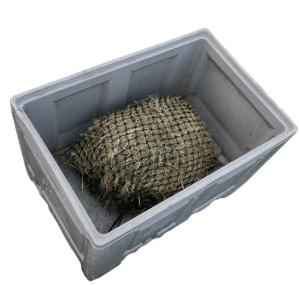The days grow shorter and the weather is getting drearier. The days of spending more time stabled have arrived; this means your horse spends less time nibbling on grass in the pasture and boredom lurks around the corner. Good quality roughage is very important for horses. An ideal way to prevent boredom is feeding roughage in a slowfeeder or haynet. HorseFitShop tells you all about using slowfeeders and hay nets.
Why is roughage important for your horse?
Horses have evolved as grazing animals, and are now used to eating small amounts of the same food all day long. A horse’s digestive system is used to a gradual intake of roughage. This gradual intake of roughage prevents digestive disorders in the stomach and intestines. It is therefore preferred to not let your horse go without roughage for more than 2 to 4 hours.
Roughage has another function, by chewing roughage your horse starts to salivate. Good salivation is vital to a horse’s health, because a horse produces gastric acids all day long. Gastric acids help digesting food and saliva in turn neutralizes the gastric acids. If your horse produces too little saliva due to a low roughage intake, gastric acid piles up because it is not being neutralized by the saliva. Additionally, this acid might splash and damage the sensitive lining of the stomach once your horse starts moving. It is therefore advised to give your horse a little roughage before a training session to avoid damage to the stomach lining and thus prevent painful ulcers.
Intestines need to be encouraged to do their work. If your horse has a regular roughage intake it’ll keep the intestines occupied and stimulates them to start working. Keeping the intestines moving is vital for a healthy digestive system. A lack of movement in the bowels can result in horse colic, specifically gas or spasmodic colic. Regular exercise is important to maintain healthy bowel movements as well.
What is the use of a slowfeeder or haynet?
Not everyone has the opportunity to feed small portions of roughage throughout the day. This problem can be solved by offering roughage to your horse in a slowfeeder or hay net. The difference between a hay net and slowfeeder is the maze size. A slowfeeder is finely mazed, whereas a hay net has slightly larger mazes.
Slower and more gradual roughage intake
Your horse takes longer to eat the roughage when it has to pull it from the haynet or slowfeeder first. This is the biggest advantage of feeding roughage by means of a haynet or slowfeeder. A more gradual and slower intake of roughage quickly reduces the chances of your horse getting digestive disorders such as colic or ulcers. Your horse keeps itself busy with the roughage for a longer period and is thus less likely to get bored.
Less spill and waste from roughage
If you feed your horse roughage from the ground it might start playing with it, step on it and it might get mixed with urine, dung and straw. Your horse will most likely leave this filthy mix be. By feeding roughage with a slowfeeder or hay net there is less spill on the ground.
Placing roughage on the ground in a paddock or sandy pasture may result in a high sand intake which in turn can result in sand colic. Additionally, parasites might enter the digestive system with the sand and cause nasty worm infections.
Less dust in roughage
Using a slowfeeder or haynet allows dust to fall out of the net and fall on the ground. This is a great bonus, if your horse has sensitive airways that easily get irritated by dust.
Weighing the roughage
A haynet can easily be weighed with a hanging scale to determine how much roughage you feed your horse. Always make sure the roughage is good quality to ensure your horse receives all the nutrients it needs.
Are there disadvantages to a slowfeeder or hay net?
Natural grazing position 
A natural position for horses whilst grazing is when they eat from the ground. This is not easily achieved with a hay net or slowfeeder. With a hay net or slowfeeder your horse has to pull the roughage from the net sideways and from
different angles. A solution to this problem is leaving the hay net or slow feeder in a large trough and tether it.
Frustration
Some horses might get frustrated and even stressed, because they feel they don’t get quick enough access to the feed. If you get the feeling your horse might be frustrated while eating from a slowfeeder try a hay net with a larger maze.
Filling a slowfeeder or hay net 
The number one annoyance of many stable keepers is having to fill a hay net or slowfeeder. They’re not the easiest thing to keep opened whilst filling it. Two hands are never enough and the process eats away time you’d rather spend on the horse. Luckily there is a solution to this problem: the
Hay Net Filler by Kerbl will take away your frustrations. Simply hang the hay net on the hooks and it’ll stay open.
Different kinds of slowfeeders and hay nets
HorseFitShop has a wide range of slowfeeders and hay nets available. The wildly popular
Hay Play is a fun, challenging and healthy way to feed your horse roughage. It is usable in the stables, paddock and pasture and rolls around in an unpredictable manner thanks to its shape.
The
hay bag large is an extra large, innovative, durable hay bag.
Check out the entire range of slowfeeders and hay nets at
HorseFitShop.